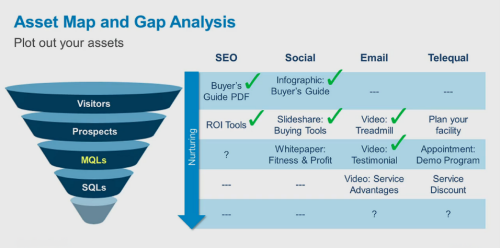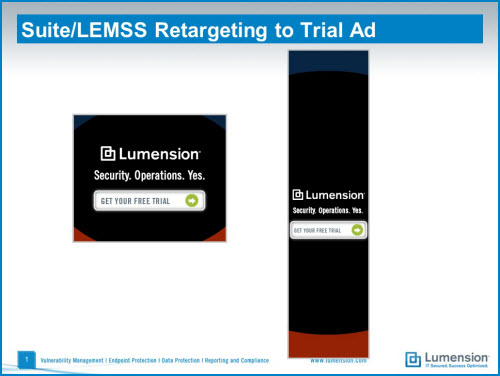by
David Kirkpatrick, Manager of Editorial Content
Another year of case studies covering B2B marketing and the complex sale has almost passed, and for today’s article, we are going to look back at some of the most compelling trends and topics we covered during 2014.
Topic #1. Focus on the customer
Today’s prospect is more informed than ever. Depending on what research you're looking at, customers in a complex sale are as far as 80 percent down the buying path before they even raise their hand and let you know they exist.
Statistics like that are the reason marketers are told to be informative and relevant with content before trying to influence that final conversion to sale — that means taking a customer-centric approach to marketing. This involves giving your prospects what they want to know rather than what you want them to learn.
We featured several case studies this year where marketing teams took a customer-centric approach to their efforts and ended up with great results:
In this case study, Cincom utilized a multi-channel campaign comprised of direct mail, email and telephone calls. The entire focus of the effort was making the customer the "hero" of the campaign, including
a baseball card in the direct mail piece highlighting customer success stories.

Click here to see the full version of this creative sample
This campaign not only resulted in a 236.7% increase in clickthrough, but it also led to a 98.5% increase in handoff to Sales.
New England Biolabs conducted both user and internal testing when
redesigning its website. By taking its customers’ input into consideration, the revamped site resulted in a 7.5% drop in bounce rate and a 13% rise in the number of page visits as well as more than a 74% increase in time spent on the new site.
This article is also tied to a revamped website, and in this case, the school put together a group of internal stakeholders to provide perspective on
key areas of importance, including:
- Alumni and Development
- Academic Leadership
- Academic Services
- Student Financial Services
- Web Committee
- Partnerships
- Graduate Studies
- Students
- Faculty
- Student Affairs
- Web and Tech Core Team
- Campus Ministry
- Academic Technology
- Prospective students and parents
From there, the team conducted email surveys with parents, prospective students, current students, alumni, faculty and staff. These results were used to create a new content strategy and a new website design that led to a 14% increase in website visit time and an impressive 94% increase in mobile website traffic. The team directly attributed these results to listening to their audience before executing the new strategies and building the new website.
SAP took its customers’ informational needs in direct consideration with a webcast campaign that featured those customers’ peers. For presenters on the webcasts, the team found SAP customers who were successfully using the company’s technology and were willing to share their story.
Through this customer-centric effort, SAP tracked $100 million in revenue influence.
Topic #2. Content is still king
This is really almost part two of the customer-centric topic because content marketing and a customer-centric focus go hand in hand. In the complex sale, informational, relevant content is the lifeblood of lead nurturing, creating both thought leadership credibility as well as brand awareness.
Here are three case studies that offer insight into content marketing strategies:
One way to provide relevant content is to create personas when segmenting the database, then send dynamically adjusted content to those segments via email. The actual email copy can be dynamically adjusted, and the webpages those separate segments are sent to can also be tied to the persona segments.
In this case study, Precor
took that approach and achieved a 74% increase in new leads as well as 67% lift in velocity from marketing-qualified leads to sales-qualified leads.

Click here to see the full version of this creative sample
VolunteerMatch also changed its approach to targeted lead nurturing email. The previous strategy was to send blast email to everyone in its database. The new campaign involves
triggered email sends based on customer behavior and provides content that is relevant to that prospect’s behavior, taking advantage of marketing automation software to accomplish this effort.
Along with decreasing the sales cycle by 99%, this new approach has facilitated a much better level of Marketing and Sales alignment.
Sherpa Software (no relation to MarketingSherpa) reached out internally to get content for a new inbound marketing strategy.
This content came from team members throughout the company and was used to create blog posts and white papers that were then shared via email newsletters and social media, while also contributing to the lead generation effort. One key result from the content-rich campaign was 137% increase in conversions as defined by a website visitor taking some sort of action on the website.
Topic #3. Retargeting can be a powerful way to be relevant
Retargeting tactics — either by sending follow-up emails or by offering up pay-per-click or banner ads for selected prospects — can be an effective way to remain top-of-mind and relevant to prospects. It’s important to be selective with this approach, but it can be a very powerful tactic to improve brand awareness.
Lumension began "dabbling in" retargeting in 2012 on trial and evaluation pages, product and solution, information and pricing. The team took note of Lumension's behavioral scoring model and knew prospects who were most likely to buy followed that general path.
When the team decided to
expand the retargeting program, they made it crystal clear they didn't want to instill retargeting with a "let's just have ads and follow people" plan. They also understood that their buying process involved four to five people to be retargeted with display ads.

Click here to see the full version of this creative sample
Amazingly, after cutting the marketing budget 30%, the retargeting effort created an 81% lift in ad impressions and an 865% increase in homepage views.
In this case study, Postano included its website visitors in a retargeting campaign and very carefully refined that campaign to determine the best display network websites would deliver the
ads to their chosen audience of marketing directors and CMOs in the sports, fashion, events and ad agency spaces.
By carefully tailoring the effort, Postano increased product demo conversion 278% and clickthrough by 364%.
This case study ran in the MarketingSherpa Email Newsletter rather than the B2B Newsletter, but it’s a great example of providing content to prospects based on what that prospect wants to receive through retargeting soft inquiries with an email, which asks those prospects where they are in the buying cycle.
Collegis Education determined its customer pathways and
developed personas for six areas:
- Business
- Education
- Health care
- Justice studies
- Design
- Technology
From there, the team used messaging maps and repurposed blog content along with highly relevant, specially created landing pages to reach each of the persona segments. This campaign ended up with a 28% open rate and a 7% conversion rate.
Creative Samples
- Cincom sample
- New England Biolab sample
- Emmanuel College sample
- Precor sample
- VolunteerMatch sample
- Lumension sample
- Postano sample
- Collegis Education sample
Related Resources
Inbound Marketing: The top three tactics from MarketingSherpa case studies in 2014Marketing Research Chart: Data on content difficulty reveals customer reviews may be overlooked by marketersNew Chart: Top tactics for developing effective B2B marketing contentGuided by Buyers: 4 tactics to create a customer-centric sales and marketing strategy













